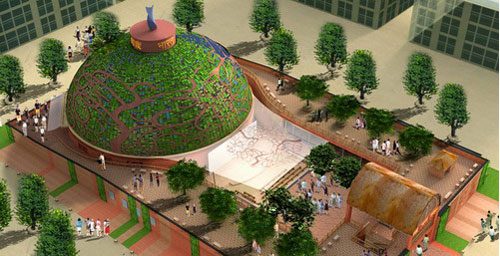Lessons from India
As India celebrates Independence Day on August 15, their Pavilion at the Shanghai World Expo is a striking soft contrast to those of concrete and steel. It has the world's largest bamboo dome and is constructed with ecologically friendly materials. The structure is modeled after the sacred Sanchi Stupa, a stone structure in central India build by Ashoka the Great, 2300 years ago, over the relics of the Buddha. Ashoka unified the Indian subcontinent and is considered an early advocate of ahimsa, the origin of Gandhi's non-violence. For example, Ashoka banned the death sentence, promoted tolerance and vegetarianism.
|
|
|
India Pavilion |
India is a remarkable country. It is home to the 5,000-year-old Indus Valley Civilization; a living caste system; suffered through British colonialism for 89 years; and became an independent state in 1947, partitioning Pakistan, but never resolving the intensive ethnic and religious conflict between Hindus and Muslims. It is the country of Gandhi with a hydrogen bomb. While an elite has prospered in recent years, the number of people living in slums has doubled in just two decades. One quarter of India lives on the equivalent of one dollar a day and 70 percent live on less than two dollars a day.
India is a pluralistic country, with highly complex and diverse cultural, linguistic (1,655 languages) and culinary traditions. Four of the world's major religions, Hinduism, Buddhism, Jainism and Sikhism, originated in India. India has 2 million religious Gods and 49,000 slums. It is a parliamentary federal republic, fashioned after the British system. While proclaimed the "largest democracy in the world" it has the largest slums in the world. The historic text of India, the Vegas, are rich in admonitions to live the perfect life yet India may be the most non-harmonious of all countries. The endless varieties of curry sauces or the films of Bollywood are known worldwide.
Only one quarter of the population lives in cities. But there are 41 one-million resident cities, double the number 40 years ago. It already has 25 of the world's 100 fasted growing cities, compared to 8 in China. The Gross Domestic Product of Mumbai is expected to exceed that of Portugal, Columbia or Malaysia in just one generation. India is the poster child for a country where the gap between urbanization and the capacity to provide urban infrastructure increases daily. The McKinsey Global Institute, in India's Urban Awaking (2010), diplomatically concluded that "India has underinvested in its cities," in contrast to China.
At the time of Independence, India was more urbanized than China. But by 2005, China's urban rate was 41 percent compared to 29 percent for India. At independence the GDP of India was twice that of China. Today China has a GDP that is at least 3.5 times greater than India. The percentage of people living below the poverty line in India is 3.5 times greater than China, life expectancy is 10 years less than China and the number of telephone lines in India is 6 times less than China. India spends just US$17 per capita on urban infrastructure capital investments, compared to US$116 in China. China has relentlessly pursued the empowerment of cities through innovations in funding, governance, planning, etc. India remains mired in a bureaucratic miasma. What explains the difference?
One explanation is the political difference between India and China. India was granted independence from British colonialism but still suffers from the legacy. China made a revolution with a single political party and a state apparatus capable of resisting market pressures and later shaping market-based reforms. China is a product of systemic approach to urbanization. India is little better than laissez-fare. Centralized state planning and the empowerment of cities have led China's urbanization. India has been a product of unchecked population growth and a feeble state and city apparatus. While China rigorously controlled the rural migration into coastal cities with the hukou system, India established no means to insure that those that entered cities could be provided services.
The contrast between China and India is striking. It offers observers in developing countries, which will account for 95 percent of future urban growth, essential lessons on what it takes to insure that urbanization includes the prospect for a better city and a better life.
Barry Weisberg is the weekly Global Cities Commentator for Worldview, Chicago Public Radio. He commutes between Shanghai and Chicago and is preparing a book, The Challenges and Choices for Cities (2011).
 0
0 








Go to Forum >>0 Comments